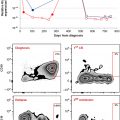Chronic Myelomonocytic Leukemia
Mayo Clinic, Rochester, MN, USA
1. What are the definition and the differential diagnosis for peripheral blood monocytosis?
Absolute monocytosis is defined by a peripheral blood AMC >1 × 109 cells/L. The differential diagnosis is categorized into clonal versus reactive. Reactive monocytosis is common and is most often seen in association with viral infections. Chronic infections and inflammatory conditions such as tuberculosis, brucellosis, leishmaniasis, sarcoidosis, and connective tissue disorders can be associated with monocytosis. Monocytosis is also one of the early signs of a recovering bone marrow (BM) following myelosuppression. Clonal monocytosis is often persistent and is associated with hematopoietic stem cell disorders such as chronic myelomonocytic leukemia (CMML), juvenile myelomonocytic leukemia (JMML), and myeloid disorders, with overlapping features between myelodysplastic syndromes (MDSs) and myeloproliferative neoplasms (MPNs).
2. What are the World Health Organization (WHO) definition and subcategorization for CMML?
CMML is a clonal hematopoietic stem cell disorder with overlapping features of MDS and MPN. It is characterized by:
- Persistent peripheral blood monocytosis >1 × 109/L
- Absence of the Philadelphia chromosome and the BCR–ABL1 fusion oncogene
- Absence of the PDGFRA or PDGFRB gene rearrangements
- Less than 20% blasts and promonocytes in the peripheral blood and bone marrow
- Dysplasia involving one or more myeloid lineages.
If myelodysplasia is absent or minimal, the diagnosis of CMML can still be made if the other requirements are met and one of the following applies: an acquired, clonal, or molecular genetic abnormality is present in the hematopoietic cells, or the monocytosis has persisted for at least 3 months and other causes of monocytosis have been excluded.
CMML is further subclassified into CMML-1 (<5% circulating blasts and <10% BM blasts) and CMML-2 (5–19% circulating blasts and 10–19% BM blasts, or when Auer rods are present irrespective of the blast count), with the median overall survival (OS) being approximately 20 and 15 months, respectively.
3. What are the epidemiology, clinical features, and presenting symptoms of patients with CMML?
The incidence of CMML has been approximated at 12.8 cases per 100,000 people per year, with the median age of presentation being 65–75 years. Patients with CMML have features overlapping between those of MDS and MPN. Those with a MDS phenotype present with or develop peripheral blood cytopenias, effort intolerance, easy bruisability, and transfusion dependence. Those with a MPN phenotype present with or develop leukocytosis, monocytosis, hepatomegaly, splenomegaly, and features of myeloproliferation.
4. What are the typical bone marrow morphological findings in patients with CMML?
The bone marrows are often hypercellular with granulocytic hyperplasia and dysplasia. Monocytic proliferation can be present but is often difficult to appreciate, and immunohistochemical studies that aid in the identification of monocytes and their precursors are recommended. Almost 80% of patients will demonstrate micro-megakaryocytes with abnormal nuclear contours and lobations, and 30% of patients can have an increase in BM reticulin fibrosis. Twenty percent of patients can demonstrate nodules composed of mature plasmacytoid dendritic cells.
5. What are the typical immunophenotypic and cytochemical bone marrow findings in patients with CMML?
On immunophenotyping, the abnormal BM cells often express myelomonocytic antigens such as CD13 and CD33, with variable expression of CD14, CD68, and CD64. Markers of aberrant expression include CD2, CD15, and CD56 or decreased expression of CD14, CD13, HLA-DR, CD64, or CD36. The presence of myeloblasts can be detected by expression of CD34. The most reliable markers on immunohistochemistry include CD68R and CD163. The monocytic cells are often positive for nonspecific esterases and lysozyme, while the granulocytic precursors are often positive for lysozyme and chloroacetate esterase.
6. What are the cytogenetic abnormalities seen in patients with CMML?
Cytogenetic abnormalities in CMML can be detected by conventional karyotyping or FISH studies. Clonal cytogenetic abnormalities are seen in approximately 20–40% of patients with CMML. Frequent aberrations include +8, monosomy 7, del7q, and recurring abnormalities of chromosome 12p. In a large Spanish cytogenetic study (n = 304), the karyotype was normal in 73% of patients. The most frequent abnormalities included +8, del5q, +10, del11q, del12p, add17p, +19, +21, abnormalities of chromosome 7, and complex karyotypes. Cytogenetic abnormalities were more frequent in patients with increased peripheral blood and BM blasts, and those who demonstrated dyserythropoiesis and dysgranulopoiesis. Based on these findings, the Spanish cytogenetic risk stratification system was developed, categorizing patients into three groups; high risk (+8, chromosome 7 abnormalities, or complex karyotype), intermediate risk (all chromosomal abnormalities except for those in the high- and low-risk categories), and low risk (normal karyotype or –Y), with 5-year OS of 4%, 26%, and 35% respectively.
7. What is the importance of detecting PDGFRA and PDGFRB gene rearrangements in patients suspected to have a diagnosis of CMML?







